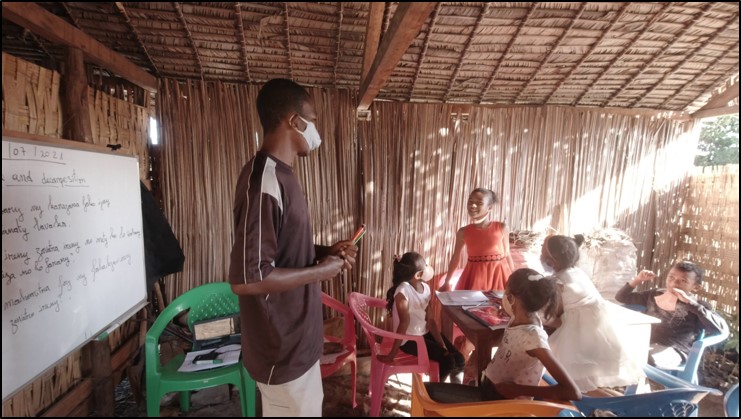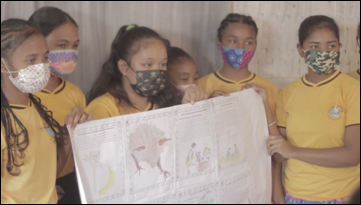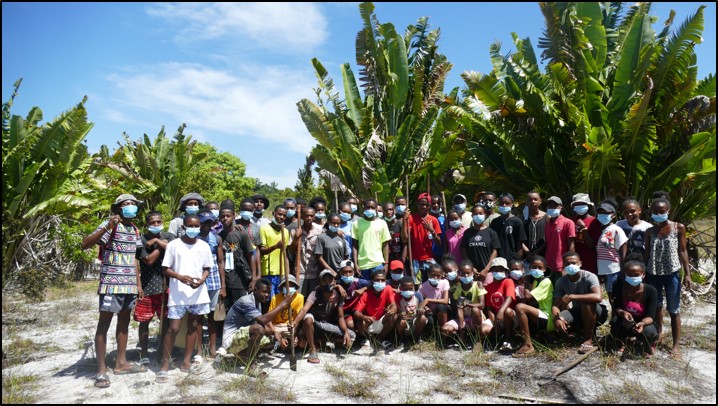Lemur awareness campaign reaches over 2,700 students, teachers, and parents in the SAVA region
Evrard Benasoavina, DLC-SAVA Conservation Education Specialist
At the DLC-SAVA Conservation Project, we believe that education is fundamental to successful conservation. We carry out many activities related to environmental education to share our passion for nature with people of all ages, genders, and in diverse settings from cities to farms, to forests.
Since beginning as Education Specialist with the DLC in 2020, I’ve led many initiatives to increase the impact of our programs:
First, I founded an environmental interpretive center called the New Generation School Garden (NGSG) with my colleagues and team from Germany. With support from generous donors and a grant from the organization GEO, we created a space where everyone can escape from the urban lifestyle to an oasis where they enjoy nature and learn about the benefits of the environment for people.
Second, I visit schools all around the SAVA region to teach about the environment, especially about the importance of forests and lemurs for people.
Third, I lead students on visits of the Marojejy National Park, a rainforest so valuable it is a UNESCO World Heritage Site.
Fourth, I engage students to participate in landscape restoration and tree-planting activities.
These activities and more are helping spread knowledge and compassion for the environment, and we hope it will inspire more conservation in the SAVA, and in Madagascar.
New Generation School Garden

More than 200 students have already learned from Evrard at his New Generational School Garden.
Since 2020, I have led school groups on tours of my garden. The tours follow a three-day sequential learning lesson plan, co-designed by me, the DLC-SAVA Conservation staff, and my colleagues in Germany—Annemarie Wurz and Viviana Uruena. We invite groups of 10 students and their teacher so that students have a personalized experience.
Activities and lesson plans build on one another to teach essential lessons including the benefits of trees and forests for people like providing shade, food, fuel, and saving the soil from erosion. We demonstrate making organic gardens with diverse vegetables. Children do nature scavenger hunts and nature journal about their experiences. They see a lot of animals at the garden like snakes, chameleons, and the fish in my fish farm.
On the third visit to the garden, children and their parents have a campout. In the evenings we tell stories and sing songs. I am always encouraged because at the end, participants say that now they understand the value of nature for people. They all agree they will do their part to protect nature. So far almost 200 children have completed their lesson plans at the NGSG and we proudly accept many more every week.
Lemur outreach campaign

Students learn about the value of lemurs and the environment and ways we can protect them.
I grew up here in the SAVA region. When I travel around the SAVA, I see a lot of people struggling to meet their daily needs. They do what they must to have food to eat. Some people will go to the forest and hunt wild animals, including tenrecs and lemurs. Sometimes lemurs are not eaten immediately, but brought home to sell. If the people cannot sell the lemur, they eat it after a while. When I see this, I try to encourage the family that this is not the way to treat lemurs, because they are wild animals and endangered with extinction. But I still understand why they do it – they need money and food.
That is the reason I travel around to many schools and marketplaces all around SAVA region to inform people about the value of lemurs and nature. I make appointments with the school administrators and teachers, and have planned visits to teach whole classes about the diversity of lemurs in the SAVA region, that they are endangered and protected, so they should not be hunted or taken as pets. I also explain why lemurs are so valuable: they are the farmers of the forest. Lemurs are important seed dispersers, and without them many trees could not grow in the forest.
So far, I have visited 17 schools, some of them multiple times, to reach all the students, and almost 1,000 participants. I regularly plan more school visits, and we plan to reach at least 20 more schools before the end of this year. I also trained teachers in Andapa and Antalaha to lead lemur awareness lessons at their schools, and we provide materials for them and follow up with them to expand further.
Visits to Marojejy National Park

A silky sifaka in Marojejy.
Most people in the SAVA region have never visited the national parks that are all around them. Even those people living next to the Marojejy National Park have never visited or don’t know what it is or why it is there. It is important for people to see these natural spaces themselves and experience them to understand more about the value of the environment. That is why I began bringing groups of school children to the national park for educational field trips.
During three visits, I guided school groups of different ages and from different places for four days in the national park. With expert local guides to tell us about the biodiversity, students learned first hand about the many species only found in the natural forests. From middle to high school, all 60 students we brought so far visited for the first time. It was their first time to see lemurs, and many saw the rare and endangered silky sifaka, only found in the SAVA region. All the students were fascinated by the animals and spent a lot of time observing them, watching what they ate, and noticed that the animals were very social, grooming each other and playing. We visit waterfalls and take a swim at the natural pools. Students don’t even mind the leeches that sometimes crawl onto their legs!
While in camp, we do lesson plans about lemurs and the importance of the environment. At the end, all students are so grateful to have the experience and ask for more ways they can help improve the environment.
Tree planting for landscape restoration

High school students volunteered to help Evrard plant 1,000 trees on his land and more planting projects are planned!
We like to engage the community in active conservation work, and they enjoy the opportunity to contribute to our efforts. Students are taking lead roles in restoring landscapes around SAVA. For example, the high school environmental club from Sambava, who finished visits to the NGSG and Marojejy with me, volunteered their Saturday to help me plant over 1,000 trees around my land. I also helped the students at the high school to organize a tree planting at their school. The students planted 250 fruiting trees all around the schoolyard, like jackfruit and soursop, and they received watering cans and instructions to maintain the trees so, in the future, the students will have lots of fruit to eat at school.
The news of our successes is spreading (we were even on TV with the local news station!), and many more schools want to participate in our mission. Another school from Sambava requested to plant 1,000 fruit trees at my NGSG with 200 of their students. We are welcoming them, and also adding native forest trees from the local Graine de Vie nursery, which provides high-quality seedlings of diverse trees for free. Also, we are planning to take another school group to Marojejy soon from a middle school in Andapa where we have already done many lemur awareness campaigns and celebrated World Lemur Day with a big event of over 1,000 people. With our partnering teachers in different districts, we are spreading knowledge and appreciation for nature and motivating people to conserve the environment.
Fisaorana – Thank you!
We are so grateful to the sponsors who make this educational programming possible, especially generous donors to our GoFundMe and PayPal drives, GEO, and DLC-SAVA Conservation supporters, notably the Cooke family! Thank you all so much. Our education activities wouldn’t be possible without you.
It costs about $150 USD per group visit to the NGSG, $250 USD for lemur outreach to each school, and $1,000 USD for a trip to Marojejy. You can contribute to these visits by making a tax-deductible donation to the DLC’s Madagascar Conservation Programs and noting “SAVA Conservation Education program.” Thank you!
Learn more

